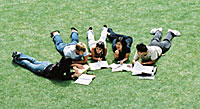| The Medieval World - HIST2201 |
|
|||||||||||||||||||||||||||||||||||||||||||

Description The Middle Ages is among the most dynamic and formative phases in world history. Deals mainly with Europe and the Mediterranean world from Late Antiquity through to the Renaissance, and covers topics such as the 'fall' of Rome, the 'Barbarian West', Byzantium, Persia and Islam, the making of Latin Christendom, the Vikings, the Crusades, and Europe's cultural and intellectual revival from 1000 AD. Important themes include sex, gender, Christianity, Islam, heresy, state formation, feudalism, imperialism and warfare.
Learning Outcomes Students will be able to:
Assessment
|
||||||||||||||||||||||||||||||||||||||||||||

| Contacts | Library | myUNSW | WebCT |